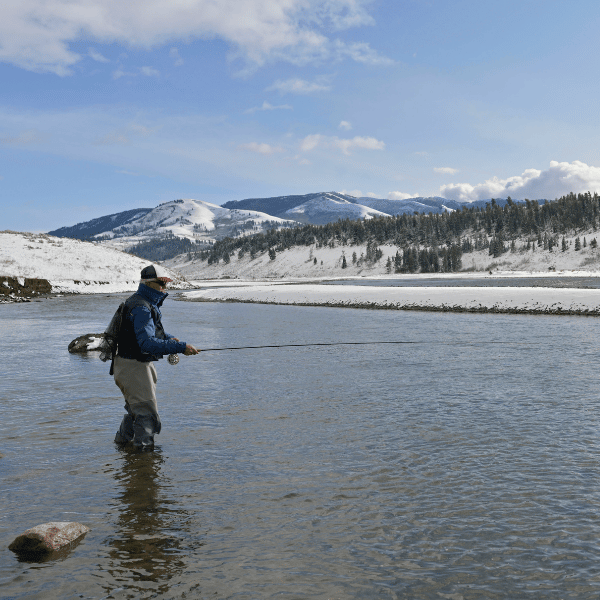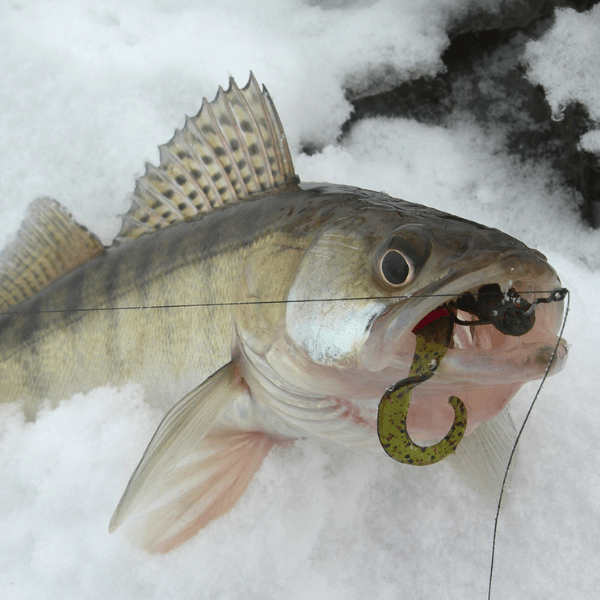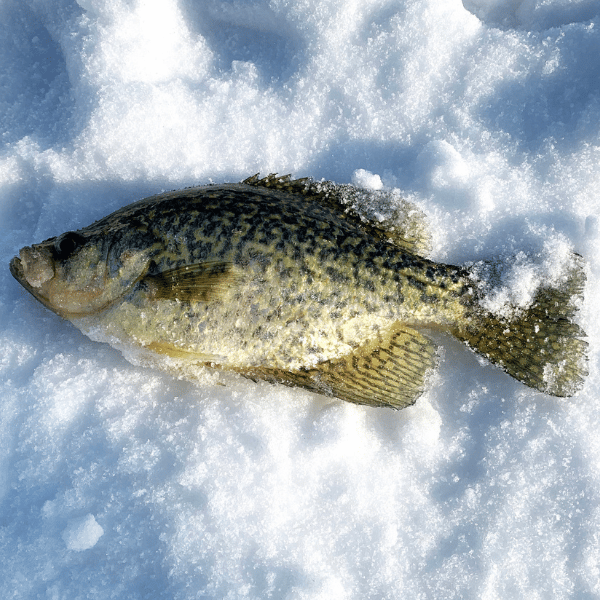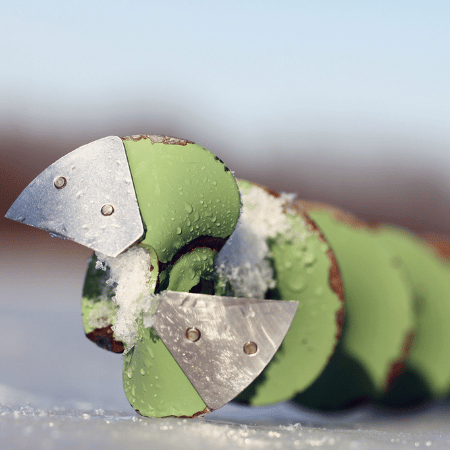Ice Fishing Tip-Up Set-Up Guide
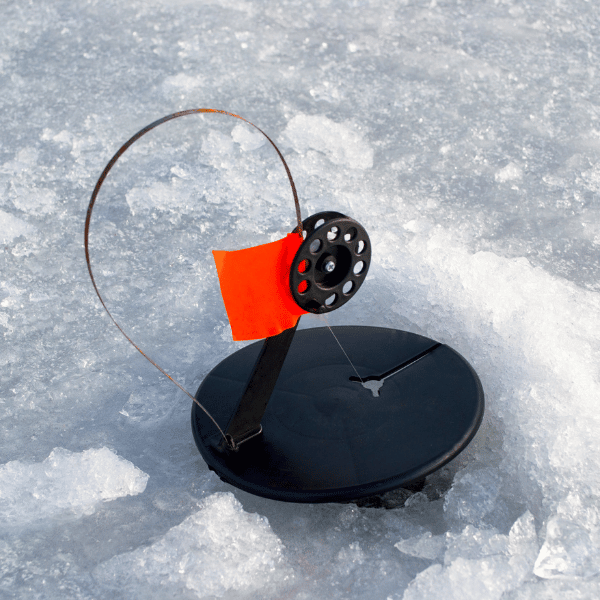
Whether you are an avid ice fisherman with years of experience or a beginner looking to improve your technique, knowing how to set up a tip-up properly is very important to the success of your catch.
Tip-ups, or lines set up to lure fish in using live bait, allow you to fish with more lines in the water in various places without having to hold onto a fishing rod. This will allow you to ice fish in multiple fishing holes at the same time without having to stick to one ice-fishing depth or location, offering a greater chance at catching a fish.
Contents
Best Way to Set-Up Ice Fishing Tip Ups

The best way to set up your ice-fishing tip-up is to pick a very durable tip-up, make sure your tip-up has a bright flag, drill a good hole in the ice, properly spool the line, correctly attach the barrel swivel, choose the right hook, and keep your bait weighted down.
Ice fishing is the perfect way to keep up with your favorite outdoor activity, even when the winter gets cold and icy. In order to get the most out of your fishing experience, you will need to have not only great warm outdoor gear that will withstand below-freezing temperatures but also the perfect tip-up set up. Read on to learn about ice-fishing tip-ups and the best way to set them up for success.
How an Ice Fishing Tip-Up Works
An ice-fishing tip-up is one of the best multi-tasking tools for any ice fisher. It allows you to fish not only one hole but many ice holes at once. This gives you a greater chance of getting your catch of the day and enjoying fresh fish for dinner.
The tip-up works by offering bait to fish without needing to hold onto a line. By utilizing a trigger system to send a bright flap up into the air, the tip-up acts as a signal that a fish has taken the bait. By setting up multiple lines or sets of bait underneath the ice, the tip-up detects a fish’s strike without needing a fisher to even be in the immediate area.
Once the tip-up recognizes a strike or a fish’s attempt to take the bait, the angler can then approach the tip-up and simply pull the fish out of the ice hole with their own hands, rather than reel it in.
The Perfect Tip-Up Set-Up
Knowing how to set up your ice-fishing tip-up can be the difference between a successful catch and a day without any fish at all. Regardless of your ice-fishing location, these set-up steps and tips will help lead you towards a triumphant and rewarding tip-up ice-fishing experience.
The Perfect Tip-Up Set-Up
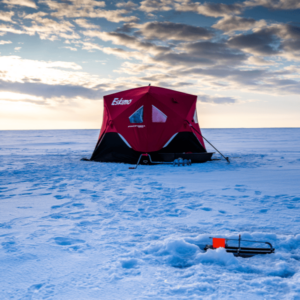
Knowing how to set up your ice-fishing tip-up can be the difference between a successful catch and a day without any fish at all. Regardless of your ice-fishing location, these set-up steps and tips will help lead you towards a triumphant and rewarding tip-up ice-fishing experience.
- Pick a Remote Location
- Spread out Your Holes
- Drill Completely into the Ice
- Choose the Right Line
- Pick a Bright Flag
- Select the Right Bait
- Watch your Flags
- Keep Your Hands Warm
Let’s now dive into each step.
Pick a Remote Location
The location you choose is almost as important as the bait you use to lure in your fish. When ice-fishing with a tip-up, it is important to be in a place that is not overpopulated with other ice fishers.
Since ice-fishing involves drilling multiple holes into the iced-over river until you are able to reach the water, it isn’t difficult to know if another ice fisher has recently used your spot. Before setting up shop to drill your holes and drop in your tip-up, make sure that the location you choose to ice fish in is not overcrowded with others.
Spread Out Your Ice Fishing Holes
It is important to spread out your holes over a large area where you will be fishing. If your holes are too close together, you are less likely to catch multiple fish, if any. Spreading out your ice-fishing holes is the best way to cover the most ground and tempt many fish from different areas to your ice-fishing tip-ups.
Drill Completely into the Ice
One mistake that is commonly made by both professional ice fishers and novices alike is the lack of ice hole depth.
It is imperative that you drill into the ice far enough that you actually pierce through to the water underneath. While some ice fishers stop drilling when they begin to feel or see thawed, unfrozen water, you must drill until there is no more ice left at all in your fishing hole. A good rule of thumb is to drill at least 3 feet deep if necessary, depending on the ice’s thickness in your location.
Choose the Right Line
An ice fisher with a faulty or cheaply made line is like a tennis player with a hole in their tennis racket. It just doesn’t make sense. Make sure to choose a fishing line that is made specifically for ice-fishing and that will not tear in intensive weather conditions.
Dacron is a special ice-fishing line made of braided nylon. It is a flexible and bendable line that can stretch. This means that it will not easily snap and will be more reliable when pulling your fish out of the water after it takes your bait.
Pick a Bright Flag
Having a bright flag is one of the best ways to keep an eye on your ice-fishing tip-up if you are away from a specific hole. The best colors to choose for your tip-up flag are:
- Bright Red
- Neon Green
- Orange
- Yellow
Your flag should be not only bright but large as well. Having a large and bright flag means that you will be able to see it from a distance. You should be able to see it from at least 100 yards away in any weather conditions. This will both improve your ice-fishing technique and act as a safety measure so that you do not end up stepping on any of your rigs.
Select the Right Bait
When you have the best bait around, the fish won’t be able to resist your properly set up ice-fishing tip-ups. The best bait for a good tip-up is smelt.
Smelt is one of the most commonly used baits for ice-fishing. Though different fish in different locations will be drawn to different types of bait, smelt is an angler’s favorite because of its natural dye.
Dyed in either yellow or green, they are considered some of the most effective bait on the market. Live minnows are also a popular choice for anglers who prefer using live bait for their tip-ups.
Watch Your Flags
Though ice-fishing with a tip-up is sometimes considered a less involved fishing method, it is still very important to keep your eye on your flags. Fishing in pairs of two or more is the most common way to ice fish because it allows you to trade off flag watching duty while also experiencing quality time with a friend or fishing buddy.
Watching your flags is imperative so as not to miss a tip-up marking when a fish has taken the bait.
Keep Your Hands Warm
Keeping your hands warm is important to an angler using a tip-up because it is common to use one’s hands to pull the fish out of the water. If your hands are cold and numb, you will not have the dexterity needed to reach into your ice-fishing hole to remove the fish. Keeping your hands warm will make it easier to retrieve the fish once it is caught in your rig.
The Right Amount of Line to Use
The amount of line that you use for your tip-up when ice-fishing will vary depending on the:
- Body of water you fish at
- Exact temperature
- Location you are in
- Time of year
However, when using a reliable Dacron line, anywhere from 50 to 75 yards should be enough. This will equal out to around 150 to 225 feet of line, meaning that it can cover anywhere from 60 to 80 foot deep waters.
How to Set Depth on a Tip-Up
After setting up your flag, putting your bait on the hook, and dropping it down the hole, you can set your tip-up depth by utilizing a piece of electronic equipment called a depth finder.
A depth finder is a little electronic dial shaped like a compass that allows you to see how many feet off the bottom of a river or lake your bait is.
By using a depth finder, you will know at which point your bait is in the perfect location. Though it will take a little bit of trial and error, the best depth for your tip-up line is to be about 2 feet off the bottom.
Tip-Ups are an Angler’s Best Friend
Tip-ups are a great way to fish while covering a lot of available water surface area. Whether you are an experienced ice fisher sitting in an ice-fishing house or a beginner ice-fishing across the span of a river, tip-ups can make your experience more fun and exciting.
Not only do they involve valuable skill and patience, but they also allow you the tremendous opportunity to catch multiple fish at one time.

